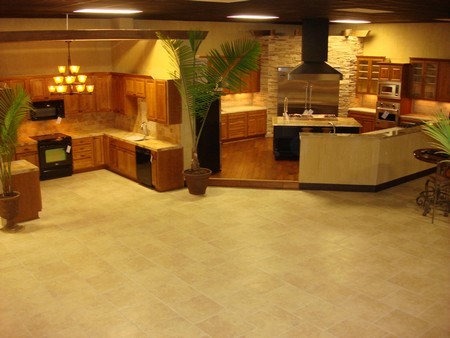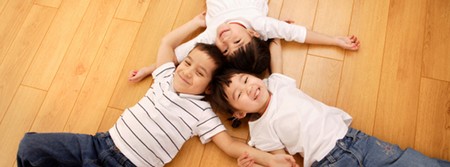Best Way to Improve Indoor Air-Quality with Hard-Surface Flooring
Although a few people argue that removing carpets is not wise, since they trap large quantities of dust that would, otherwise, be circulating freely in the air experts in general advise hard-surface flooring as a healthier alternative. A simple cleaning routine will ensure dust does not accumulate. If you decide to retain the comfort factor and have a fitted carpet in the living or family rooms, then still consider taking carpets and non-washable rugs out of children’s bedrooms, since children spend so much time sleeping or playing in their rooms.
Choice of materials
There are several choices of hard-surface flooring available, including hardwood, linoleum, vinyl, and ceramic tiles.
Ceramic tiles are particularly suitable for the “wet” rooms of the home – the kitchen and bathroom -while linoleum and vinyl flooring, which is available in an extremely wide range of colours and designs, can be installed successfully in any room. If linoleum or vinyl is used in bathrooms and kitchens, however, you will have to wipe up any water spills quickly to stop moisture working its way underneath the material. Cork is another option, but there is the possibility of it becoming colonized by mites. This is less likely if sealed cork is used.
Hardwood floors should be sealed if used in a kitchen or bathroom to prevent water penetration.
Hardwood
Modern hardwood flooring is often available as a laminated material – a thin hardwood layer is glued to a plywood or other artificial wooden base. It is nearly always prestained and prefinished. In general, water-based adhesives, stains, and other finishes give off less odour and “out-gas” less than solvent-based finishes. Laminated floors are cheaper than solid-wood floors, but they cannot be sanded down later or refinished as real wood can. Solid-wood flooring comprises planks or parquet (patterned blocks).
Linoleum or vinyl
Due to its low cost, ease of installation, and the wide range of patterns and colours available, vinyl and linoleum flooring is very popular. Vinyl flooring is made from vinyl plastic, primarily polyvinyl chloride (PVC). When new, it out-gases high levels of chemicals, particularly plasticizers. Although linoleum is made from natural ingredients, it is based on linseed oil, which, when new, gives off a powerful odour that may cause respiratory irritation. If you are fitting either of these materials, open windows and thoroughly air the room until the smell has completely disappeared. This should not take more than a few days.
Ceramic tiling
There are various types of ceramic tiles to choose from, with mosaic, quarry, glazed, and slate tiles being popular These are available in sizes, colours, and surface textures to suit most styles and situations. Glazed or vitreous tiles have an impervious surface and do not need to be sealed. Porous, unsealed tiles may harbour bacteria and other microorganisms and easily become stained. To make cleaning easier porous tiles should always be sealed when used in kitchens and bathrooms.
The grouting between tiles can harbour mould if it becomes cracked or is constantly damp. Most common allergenic moulds prefer an acidic environment, so it is best to choose a grouting that is strongly alkaline in its chemical composition.
Categories
Advertisements
Recent Articles
 How to Understand Bed Sizes – A Small Guide
How to Understand Bed Sizes – A Small Guide How to Select Some Must Have Kitchen Accessories
How to Select Some Must Have Kitchen Accessories Best Way to Change a Car Tire
Best Way to Change a Car Tire Best Way to Write an Affirmation
Best Way to Write an Affirmation Best Way to Take Charge of Your Financial Life
Best Way to Take Charge of Your Financial Life Best Way to Survive a Party When You Don’t Know Anyone
Best Way to Survive a Party When You Don’t Know Anyone Best Way to Stop Self Sabotaging Yourself
Best Way to Stop Self Sabotaging Yourself Best Way to Start Journal Writing
Best Way to Start Journal Writing Best Way to Speak with a Powerful Voice
Best Way to Speak with a Powerful Voice Best Way to Simplify Your Life
Best Way to Simplify Your Life Best Way to Respond to a Put-Down
Best Way to Respond to a Put-Down Best Way to Reduce Acne Breakouts
Best Way to Reduce Acne Breakouts Best Way to Recover from Dining Disasters
Best Way to Recover from Dining Disasters Best Way to Quit Your Job Gracefully
Best Way to Quit Your Job Gracefully Best Way to Make Your Own Website
Best Way to Make Your Own Website



Leave a Reply